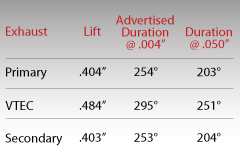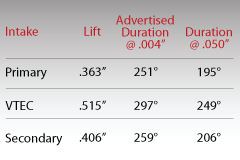A couple of things about the K24 engine first.
It comprises of two systems. The VTC part (Variable Valve Timing Control), and the LC part (Lift Control).
In this first picture of the engine in my car, you can see the inlet camshaft on the right and the exhaust camshaft on the left
i.e. the picture is taken from the driver's side of the car
The large sprocket on the inlet camshaft, allows the angle of the camshaft to be dynamically changed relative to the sprocket
i.e. the phase of the camshaft can be altered relative to the timing chain
This is the VTC part.
In this second picture, the inlet camshaft is at the bottom and the exhaust camshaft is at the top (the timing chain can just be seen on the left). If you look along the inlet camshaft to the 3rd cylinder from the left, you can see the high-lift cam in the middle of the lower-lift cams. When the LC is engaged, this cam will open both valves and the other two cams become redundant. The exhaust is the same (can be seen on the 4th cylinder from the left)
Here is a picture of the Skunk2 camshafts (these are for the K20A2), exhaust at the top and inlet at the bottom
So if you bought the camshafts for the K24A3 engine in your car, you would simply swap them with the ones in the middle picture.
Now to answer your question "would a remap be required", IMO the answer is "it is not required, but a remap to bring in the LC sooner would be more useful".
So if you didn't change the cams and had a remap, then one of the main improvements is to bring in the LC sooner. I'm not sure if the VVT would also be changed in a remap, Fahad would tell you. But AFAIK, there isn't much else you can change with a remap on a K24 engine. Put another way, a remap of an ECU on a conventional non-VTC, non-LC, or non-boost-pressure engine would give hardly any improvement (if at all).
The thing to bear in mind is that the ECU on the K24 controls (not in any particular order)
1. VTC
2. LC
3. EI (Electronic Ignition) timing
4. AFR ... Air-Fuel Ratio ... controlled by the EFI part (Electronic Fuel Injection)
To all intents, you can consider these as separate systems, as if the engine had mechanical VTC and LC with limited electronic input, with a separate EI, and a standard EFI. At a guess, I would think that early Honda VTEC engines fit this description.
If you go back to an engine without VTC or LC, that has EI and a carb, then changing the camshafts on their own will alter the torque curve and hence the power delivery, without changing anything else, provided that the carb could still run at the correct AFR in the new range of air flows. Normally, one would expect to change the camshafts and the carb at least ...and this is why you may be thinking that a remap would be required. But an EFI system is like having separate carbs that self-tune to keep the AFR constant over a wider range of air-flows.
So what would be the difference with these camshafts. I would think that its mainly the lobe shapes (durations) and phases angles that are slightly different, but as they mention, you would really need their inlet manifold and throttle body as well. And then a remap to bring it all together.
Why did Honda not fit camshafts like this in the first place. Because the camshaft, manifolds, and engine map are a compromise that they make to
1. keep the engine quiet
2. keep emissions down
3. keep the mpg up
4. give flexible range of torque - driveability
5. provide a bit of power at the top end
6. keep service intervals down
7. keep reliability up






